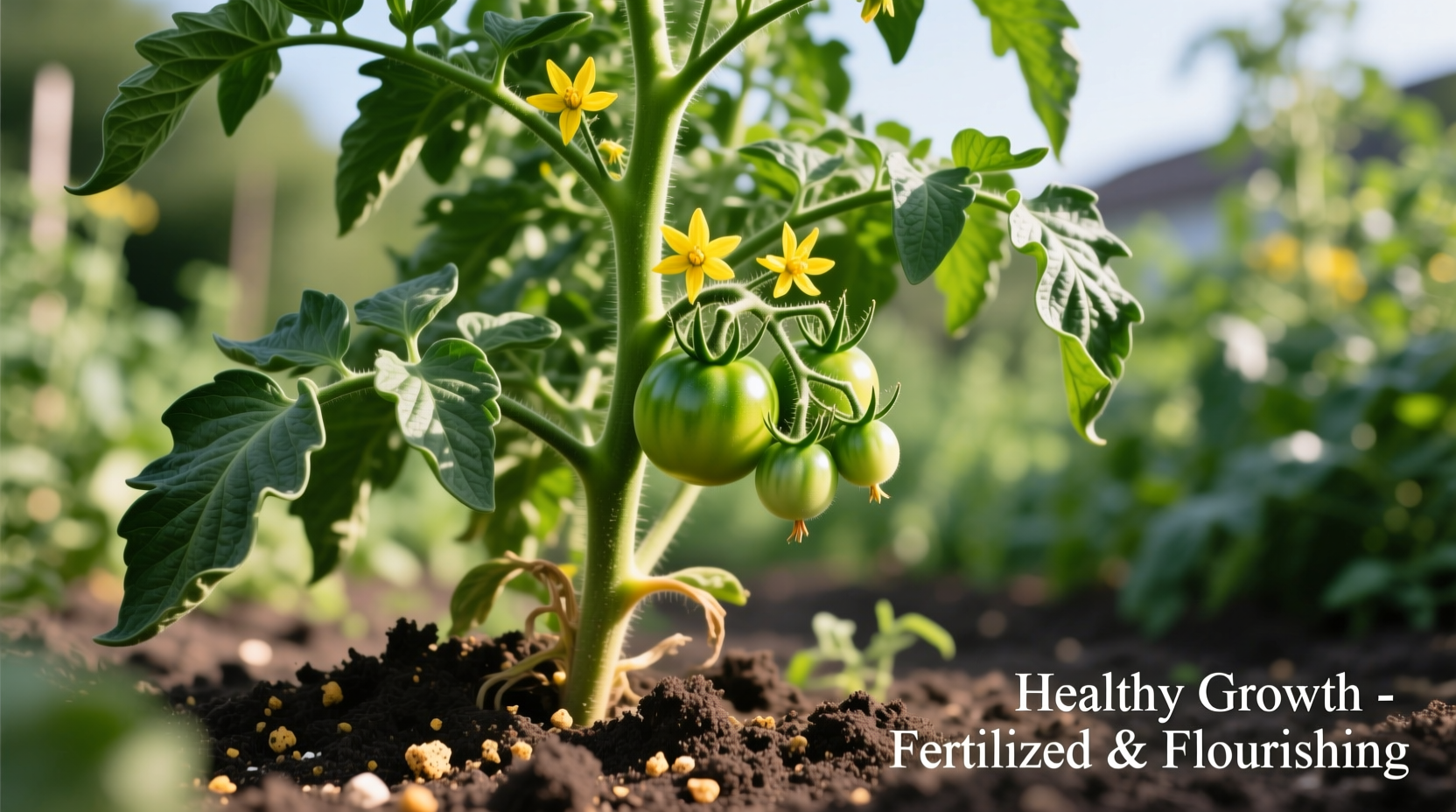Properly fertilizing tomato plants requires applying balanced fertilizer with an NPK ratio of 5-10-10 at transplanting, followed by regular applications every 2-3 weeks during fruiting season. Organic options like compost tea and fish emulsion work well, but avoid high-nitrogen formulas that promote leafy growth over fruit production. The critical timing window is during flowering and fruit set when phosphorus and potassium needs peak.
Why Proper Fertilization Makes or Breaks Your Tomato Harvest
Getting fertilizer right separates disappointing tomato crops from abundant harvests. Tomatoes are heavy feeders that deplete soil nutrients rapidly, but over-fertilizing causes more problems than under-fertilizing. The sweet spot lies in understanding exactly when and what to apply at each growth stage.
Your Step-by-Step Fertilizing Roadmap
Pre-Planting Soil Preparation: The Foundation
Before your seedlings even touch the soil, build nutrient reserves with these steps:
- Mix 3-4 inches of well-aged compost into planting beds (adds slow-release nutrients)
- Conduct a soil test through your local extension service to identify deficiencies
- Incorporate bone meal (for phosphorus) if your soil test shows low levels
- Adjust pH to 6.2-6.8 using lime (to raise) or sulfur (to lower) as needed
| Soil Test Result | Action Required | Timeline |
|---|---|---|
| pH below 6.0 | Add agricultural lime (5 lbs per 100 sq ft) | 4 weeks before planting |
| Low phosphorus | Mix bone meal (2 cups per plant) | At planting time |
| Low potassium | Add greensand (1 cup per plant) | At planting time |
Transplanting Stage: Jumpstarting Growth
When moving seedlings to the garden, give them a nutrient boost:
- Use starter solution: 1 tablespoon fish emulsion per gallon of water
- Apply 1 cup per plant directly to root zone
- Avoid high-nitrogen fertilizers that encourage leafy growth over roots

Vegetative Growth Phase: Building Strength
During the first 3-4 weeks after transplanting:
- Hold off on additional fertilizer if you amended soil properly
- Watch for pale leaves (nitrogen deficiency) or purple undersides (phosphorus deficiency)
- If needed, apply balanced organic fertilizer (5-5-5) at half strength
Flowering and Fruit Set: The Critical Window
This is when your fertilizing strategy determines yield quality:
- Switch to low-nitrogen, high-phosphorus/potassium formula (like 3-8-8)
- Apply every 2-3 weeks during fruiting season
- Water thoroughly before fertilizing to prevent root burn
- Side-dress by digging 2-inch trench 6 inches from stem
Mid-Season Maintenance: Sustaining Production
As tomatoes begin ripening:
- Continue bi-weekly applications of potassium-rich fertilizer
- Supplement with calcium spray to prevent blossom end rot
- Reduce nitrogen completely once first fruits set
- Monitor for yellowing between veins (magnesium deficiency)
Fertilizer Type Comparison: Making the Right Choice
Not all tomato fertilizers work equally well. Consider these factors when selecting:
| Fertilizer Type | Best For | Application Rate | Key Benefit |
|---|---|---|---|
| Compost tea | Organic gardens | 2 gallons per plant weekly | Microbial activity boost |
| Fish emulsion | Quick nutrient boost | 3 tbsp per gallon, bi-weekly | Balanced NPK with trace minerals |
| Tomato-specific granular | Convenience | Follow package directions | Formulated for fruiting needs |
| Worm castings | Soil health focus | 1 cup per plant monthly | Slow-release nutrients |
Avoiding Costly Fertilizing Mistakes
Even experienced gardeners make these common errors:
Over-Fertilization: The Silent Yield Killer
Excess nitrogen creates lush foliage but few fruits. Signs include:
- Dark green, excessive leaf growth
- Fewer flowers and fruit drop
- Burned leaf edges (fertilizer burn)
If you've over-fertilized, flush soil with water and skip next application. According to Cornell University Cooperative Extension, "Nitrogen levels above 150 ppm can reduce fruit set by up to 40% in tomatoes."
Under-Fertilization: The Slow Decline
Insufficient nutrients show as:
- Pale or yellowing older leaves (nitrogen deficiency)
- Purple discoloration on undersides (phosphorus deficiency)
- Blossom end rot (calcium deficiency)
Correct deficiencies gradually - sudden nutrient surges stress plants. The University of California Agriculture and Natural Resources notes that "Tomato plants require approximately 2.5-3.5 lbs of nitrogen per acre during the growing season for optimal production."
Special Considerations for Different Growing Conditions
Container Gardening Adjustments
Potted tomatoes need different care:
- Use half-strength liquid fertilizer weekly (containers leach nutrients faster)
- Choose slow-release formulas specifically for containers
- Monitor pH more frequently (container media pH shifts faster)
Organic vs. Synthetic: Making the Right Choice
Both approaches work when applied correctly:
- Organic options (compost, fish emulsion, kelp): Feed soil microbes, release slowly, improve soil structure
- Synthetic options: Provide immediate nutrients, precise NPK control, risk of salt buildup
The USDA Natural Resources Conservation Service emphasizes that "Organic matter additions improve soil's ability to retain both water and nutrients, reducing fertilizer requirements by up to 30%." However, synthetic fertilizers provide more precise nutrient control for correcting specific deficiencies.
Regional Climate Adjustments
Your location affects fertilizing needs:
- Cool climates: Delay first application until soil warms to 60°F
- Hot climates: Fertilize in early morning, increase potassium for heat stress
- High rainfall areas: Use slow-release formulas to prevent nutrient leaching
Reading Your Plants: The Ultimate Fertilizer Guide
Your tomato plants tell you exactly what they need if you know how to look:
| Symptom | Deficiency | Solution |
|---|---|---|
| Yellowing between veins | Magnesium | Epsom salt spray (1 tbsp/gal) |
| Purple undersides | Phosphorus | Bone meal application |
| Blossom end rot | Calcium | Calcium nitrate spray |
| Weak stems | Potassium | Wood ash side-dressing |
Season-Long Fertilizing Timeline
Follow this precise schedule for maximum harvests:
- Pre-planting: Soil amendment with compost and pH adjustment
- Transplanting: Starter solution (fish emulsion)
- 3 weeks after transplant: First side-dressing with balanced fertilizer
- First flowers: Switch to low-nitrogen, high-phosphorus formula
- First fruit set: Bi-weekly potassium-rich applications
- Mid-season: Supplement with calcium and magnesium as needed
- End of season: Stop all nitrogen applications to ripen existing fruit











 浙公网安备
33010002000092号
浙公网安备
33010002000092号 浙B2-20120091-4
浙B2-20120091-4